- ▶
- Heaters/Source
- ▶
- Agilent Heaters and SensorsMass Spectrometry, Scientific Supplies & ManufacturingScientific Instrument Services 5973 Source Heater Tamper Resistant Allen Wrench 5973/5975 Quad Sensor 5985 Source Heater Assembly Agilent Interface Heater Assembly 5971 Interface Heater

- ▶
- Reference Material on InstrumentationArticle - A High Temperature Direct Probe for a Mass Spectrometer Design of a Direct Exposure Probe and Controller for use ona Hewlett-Packard 5989 Mass Spectrometer SIS AP1000 AutoProbe™ SIS AP2000 AutoProbe™ - Description of System HPP7: Direct Probe Electronics Console HPP7: Direct Probe for the Agilent (HP) 5973/5975 MSD HPP7: HP Direct Probe Application Notes HPP7: Installation Directions for the Direct Probe HPP7: Side Cover for the HP 5973 MSD HPP7: Support HPP7: Probe Inlet System for the Agilent (HP) 5973 and 5975 MSD with Automatic Indexed Stops HPP7: Theory of Operation of the Direct Probe and Probe Inlet System Direct Thermal Extraction Thermal Desorption Application Notes Environmental Thermal Desorption Application Notes Food Science Thermal Desorption Application Notes Forensic Thermal Desorption Application Notes GC Cryo-Trap Application Notes Headspace Application Notes Purge & Trap Thermal Desorption Application Notes Theory of Operation of the AutoDesorb® System AutoDesorb Notes for SIS Dealers Adsorbent Resin Application Notes Installation of the Short Path Thermal Desorption System on Agilent (HP) and Other GCs Installation of the Short Path Thermal Desorption System on a Varian 3400 GC AutoDesorb® System Development Team Thermal Desorption Applications and Reference Materials Installation of the Short Path Thermal Desorption System - TD5 Part I - Design & Operation of the Short Path ThermalDesorption System Installation Instructions for the Model 951 GC Cryo-Trap on the HP 5890 Series GC Installation Instructions for the Model 961 GC Cryo-Trap on the HP 5890 Series GC Operation of the Model 951/961 GC Cryo-Trap SIS GC Cryo Traps - Theory of Operation NIST/EPA/NIH Mass Spectral Enhancements - 1998 version (NIST98) SIMION 3D Ion Optics Class Mass Spectrometer Source Cleaning Methods MS Tip: Mass Spectrometer Source Cleaning Procedures Mass Spec Source Cleaning Procedures Micro-Mesh® Abrasive Sheets Research Papers Using New Era Syringe Pump Systems EI Positive Ion Spectra for Perfluorokerosene (PFK) Cap Liner Information How do I convert between fluid oz and milliliters? Which bottle material should I choose? Which bottle mouth should I choose? The Bottle Selection Guide CGA Connections for Gas Tanks Chemical Reaction Interface Mass Spectrometry (CRIMS)

- TD
- ▶
- AccessoriesTD Supply Kit Desorption Tubes Adsorbent Resins Desorption Tube Needles Desorption Tube Seals Desorption System Fittings GC Cryo-Trap Extraction Cell TD Sample Loader Prepacked, Conditioned Desorption Tubes Desorption Tube Packing Accessories Stainless Steel Purge Heads Injection Port Liners Tenax TA Poster TD Application Notes Customer Service

- LiteratureApplication Notes Adsorbent Resins Guide Mass Spec Tips SDS Sheets FAQ MS Calibration Compound Spectra Manuals MS Links/Labs/ Organizations MS Online Tools Flyers on Products/Services Scientific Supplies Catalog About Us NextAdvance Bullet Blender® Homogenizer Protocols Micro-Mesh® Literature Instrumentation Literature Agilent GC/MS Literature SIS News / E-Mail Newsletter NIST MS Database - Update Notifications

- ▶
- Purge & Trap Thermal Desorption Application NotesNote 97: Flavor Profiles of Imported and Domestic Beers by Purge & Trap Thermal Desorption GC/MS Note 93: Detection of Benzene in Carbonated Beverages with Purge & Trap Thermal Desorption GC/MS Note 43: Volatile Organic Composition In Blueberries Note 42: The Influence of Pump Oil Purity on Roughing Pumps Note 38: A New Micro Cryo-Trap For Trapping Of Volatiles At the Front Of a GC Capillary Column Note 35: Volatile Organics Composition of Cranberries Note 34: Selection Of Thermal Desorption and Cryo-Trap Parameters In the Analysis Of Teas Note 33: Changes in Volatile Organic Composition in Milk Over Time Note 32: Selection and Use of Adsorbent Resins for Purge and Trap Thermal Desorption Applications Note 31: Volatile Organic Composition in Several Cultivars of Peaches Note 30: Comparison Of Cooking Oils By Direct Thermal Extraction and Purge and Trap GC/MS Note 26: Volatile Organics Present in Recycled Air Aboard a Commercial Airliner Note 25: Flavor and Aroma in Natural Bee Honey Note 23: Frangrance Qualities in Colognes Note 22: Comparison Of Volatile Compounds In Latex Paints Note 21: Detection and Identification Of Volatile and Semi-Volatile Organics In Synthetic Polymers Used In Food and Pharmaceutical Packaging Note 20: Using Direct Thermal Desorption to Assess the Potential Pool of Styrene and 4-Phenylcyclohexene In Latex-Backed Carpets Note 18: Determination of Volatile Organic Compounds In Mushrooms Note 17: Identification of Volatile Organics in Wines Over Time Note 16: Analysis of Indoor Air and Sources of Indoor Air Contamination by Thermal Desorption Note 14: Identification of Volatiles and Semi-Volatiles In Carbonated Colas Note 8: Detection of Volatile Organic Compounds In Liquids Utilizing the Short Path Thermal Desorption System Note 3: Indoor Air Pollution Note 2: Detection of Arson Accelerants Using Dynamic Headspace with Tenax® Cartridges Thermal Desorption and Cryofocusing

- Thermal Desorption Applications and Reference MaterialsDirect Thermal Extraction Headspace Environmental Food Science Applications Pharmaceuticals Forensic Note 103: EPA Method 325B, Novel Thermal Desorption Instrument Modification to Improve Sensitivity Note 102: Identification of Contaminants in Powdered Beverages by Direct Extraction Thermal Desorption GC/MS Note 101: Identification of Contaminants in Powdered Foods by Direct Extraction Thermal Desorption GC/MS Note 100: Volatile and Semi-Volatile Profile Comparison of Whole Versus Cracked Versus Dry Homogenized Barley Grains by Direct Thermal Extraction Note 99: Volatile and Semi-Volatile Profile Comparison of Whole vs. Dry Homogenized Wheat, Rye and Barley Grains by Direct Thermal Extraction GC/MS Note 98: Flavor and Aroma Profiles of Truffle Oils by Thermal Desorption GC/MS Note 97: Flavor Profiles of Imported and Domestic Beers by Purge & Trap Thermal Desorption GC/MS Note 95: Detection of Explosives on Clothing Material by Direct and AirSampling Thermal Desorption GC/MS Note 94: Detection of Nepetalactone in the Nepeta Cataria Plant by Thermal Desorption GC/MS Note 93: Detection of Benzene in Carbonated Beverages with Purge & Trap Thermal Desorption GC/MS Note 88: Analysis of Silicone Contaminants on Electronic Components by Thermal Desorption GC-MS Note 84: Vacuum Pump Exhaust Filters - Charcoal Exhaust Traps Note 83: Vacuum Pump Exhaust Filters - Oil Mist Eliminators Note 82: Vacuum Pump Exhaust Filters Note 80: Design, Development and Testing of a Microprocessor ControlledAutomated Short Path Thermal Desorption Apparatus Note 79: Volatile Organic Compounds From Electron Beam Cured and Partially Electron Beam Cured Packaging Using Automated Short Path Thermal Desorption Note 77: The Determination of Volatile Organic Compounds in VacuumSystem Components Note 75: An Apparatus for Sampling Volatile Organics From LivePlant Material Using Short Path Thermal Desorption Note 73: The Analysis of Perfumes and their Effect on Indoor Air Pollution Note 71: Flavor Profile Determination of Rice Samples Using Shor tPath Thermal Desorption GC Methods Note 65: Determination of Ethylene by Adsorbent Trapping and Thermal Desorption - Gas Chromatography Note 64: Comparison of Various GC/MS Techniques For the Analysis of Black Pepper (Piper Nigrum) Note 63: Determination of Volatile and Semi-Volatile Organics in Printer Toners Using Thermal Desorption GC Techniques Note 60: Programmable Temperature Ramping of Samples Analyzed ViaDirect Thermal Extraction GC/MS Note 57: Aroma Profiles of Lavandula species Note 55: Seasonal Variation in Flower Volatiles Note 54: Identification of Volatile Organic Compounds in Office Products Note 43: Volatile Organic Composition In Blueberries Note 42: The Influence of Pump Oil Purity on Roughing Pumps Note 41: Hydrocarbon Production in Pine by Direct Thermal Extraction Note 40: Comparison of Septa by Direct Thermal Extraction Note 39: Comparison of Sensitivity Of Headspace GC, Purge and Trap Thermal Desorption and Direct Thermal Extraction Techniques For Volatile Organics Note 38: A New Micro Cryo-Trap For Trapping Of Volatiles At the Front Of a GC Capillary Column Note 37: Volatile Organic Emissions from Automobile Tires Note 36: Identification Of Volatile Organic Compounds In a New Automobile Note 35: Volatile Organics Composition of Cranberries Note 34: Selection Of Thermal Desorption and Cryo-Trap Parameters In the Analysis Of Teas Note 33: Changes in Volatile Organic Composition in Milk Over Time Note 32: Selection and Use of Adsorbent Resins for Purge and Trap Thermal Desorption Applications Note 31: Volatile Organic Composition in Several Cultivars of Peaches Note 30: Comparison Of Cooking Oils By Direct Thermal Extraction and Purge and Trap GC/MS Note 29: Analysis Of Volatile Organics In Oil Base Paints By Automated Headspace Sampling and GC Cryo-Focusing Note 28: Analysis Of Volatile Organics In Latex Paints By Automated Headspace Sampling and GC Cryo-Focusing Note 27: Analysis of Volatile Organics In Soils By Automated Headspace GC Note 26: Volatile Organics Present in Recycled Air Aboard a Commercial Airliner Note 25: Flavor and Aroma in Natural Bee Honey Note 24: Selection of GC Guard Columns For Use With the GC Cryo-Trap Note 23: Frangrance Qualities in Colognes Note 22: Comparison Of Volatile Compounds In Latex Paints Note 21: Detection and Identification Of Volatile and Semi-Volatile Organics In Synthetic Polymers Used In Food and Pharmaceutical Packaging Note 20: Using Direct Thermal Desorption to Assess the Potential Pool of Styrene and 4-Phenylcyclohexene In Latex-Backed Carpets Note 19: A New Programmable Cryo-Cooling/Heating Trap for the Cryo-Focusing of Volatiles and Semi-Volatiles at the Head of GC Capillary Columns Note 18: Determination of Volatile Organic Compounds In Mushrooms Note 17: Identification of Volatile Organics in Wines Over Time Note 16: Analysis of Indoor Air and Sources of Indoor Air Contamination by Thermal Desorption Note 14: Identification of Volatiles and Semi-Volatiles In Carbonated Colas Note 13: Identification and Quantification of Semi-Volatiles In Soil Using Direct Thermal Desorption Note 12: Identification of the Volatile and Semi-Volatile Organics In Chewing Gums By Direct Thermal Desorption Note 11: Flavor/Fragrance Profiles of Instant and Ground Coffees By Short Path Thermal Desorption Note 10: Quantification of Naphthalene In a Contaminated Pharmaceutical Product By Short Path Thermal Desorption Note 9: Methodologies For the Quantification Of Purge and Trap Thermal Desorption and Direct Thermal Desorption Analyses Note 8: Detection of Volatile Organic Compounds In Liquids Utilizing the Short Path Thermal Desorption System Note 7: Chemical Residue Analysis of Pharmaceuticals Using The Short Path Thermal Desorption System Note 6: Direct Thermal Analysis of Plastic Food Wraps Using the Short Path Thermal Desorption System Note 5: Direct Thermal Analysis Using the Short Path Thermal Desorption System Note 4: Direct Analysis of Spices and Coffee Note 3: Indoor Air Pollution Note 2: Detection of Arson Accelerants Using Dynamic Headspace with Tenax® Cartridges Thermal Desorption and Cryofocusing Note 1: Determination of Off-Odors and Other Volatile Organics In Food Packaging Films By Direct Thermal Analysis-GC-MS

- ▶
- Food Science Thermal Desorption Application NotesNote 102: Identification of Contaminants in Powdered Beverages by Direct Extraction Thermal Desorption GC/MS Note 101: Identification of Contaminants in Powdered Foods by Direct Extraction Thermal Desorption GC/MS Note 98: Flavor and Aroma Profiles of Truffle Oils by Thermal Desorption GC/MS Note 93: Detection of Benzene in Carbonated Beverages with Purge & Trap Thermal Desorption GC/MS Note 43: Volatile Organic Composition In Blueberries Note 41: Hydrocarbon Production in Pine by Direct Thermal Extraction Note 35: Volatile Organics Composition of Cranberries Note 33: Changes in Volatile Organic Composition in Milk Over Time Note 31: Volatile Organic Composition in Several Cultivars of Peaches Note 30: Comparison Of Cooking Oils By Direct Thermal Extraction and Purge and Trap GC/MS Note 25: Flavor and Aroma in Natural Bee Honey Note 21: Detection and Identification Of Volatile and Semi-Volatile Organics In Synthetic Polymers Used In Food and Pharmaceutical Packaging Note 18: Determination of Volatile Organic Compounds In Mushrooms Note 17: Identification of Volatile Organics in Wines Over Time Note 14: Identification of Volatiles and Semi-Volatiles In Carbonated Colas Note 12: Identification of the Volatile and Semi-Volatile Organics In Chewing Gums By Direct Thermal Desorption Note 11: Flavor/Fragrance Profiles of Instant and Ground Coffees By Short Path Thermal Desorption Note 9: Methodologies For the Quantification Of Purge and Trap Thermal Desorption and Direct Thermal Desorption Analyses Note 8: Detection of Volatile Organic Compounds In Liquids Utilizing the Short Path Thermal Desorption System Note 6: Direct Thermal Analysis of Plastic Food Wraps Using the Short Path Thermal Desorption System Note 5: Direct Thermal Analysis Using the Short Path Thermal Desorption System Note 4: Direct Analysis of Spices and Coffee Note 1: Determination of Off-Odors and Other Volatile Organics In Food Packaging Films By Direct Thermal Analysis-GC-MS

- Application NotesNote 103: EPA Method 325B, Novel Thermal Desorption Instrument Modification to Improve Sensitivity Note 102: Identification of Contaminants in Powdered Beverages by Direct Extraction Thermal Desorption GC/MS Note 101: Identification of Contaminants in Powdered Foods by Direct Extraction Thermal Desorption GC/MS Note 100: Volatile and Semi-Volatile Profile Comparison of Whole Versus Cracked Versus Dry Homogenized Barley Grains by Direct Thermal Extraction Note 99: Volatile and Semi-Volatile Profile Comparison of Whole vs. Dry Homogenized Wheat, Rye and Barley Grains by Direct Thermal Extraction GC/MS Note 98: Flavor and Aroma Profiles of Truffle Oils by Thermal Desorption GC/MS Note 97: Flavor Profiles of Imported and Domestic Beers by Purge & Trap Thermal Desorption GC/MS Note 96: Reducing Warping in Mass Spectrometer Filaments, with SISAlloy® Yttria/Rhenium Filaments Note 95: Detection of Explosives on Clothing Material by Direct and AirSampling Thermal Desorption GC/MS Note 94: Detection of Nepetalactone in the Nepeta Cataria Plant by Thermal Desorption GC/MS Note 93: Detection of Benzene in Carbonated Beverages with Purge & Trap Thermal Desorption GC/MS Note 92: Yttria Coated Mass Spectrometer Filaments Note 91: AutoProbe DEP Probe Tip Temperatures Note 90: An Automated MS Direct Probe for use in an Open Access Environment Note 89: Quantitation of Organics via a Mass Spectrometer Automated Direct Probe Note 88: Analysis of Silicone Contaminants on Electronic Components by Thermal Desorption GC-MS Note 87: Design and Development of an Automated Direct Probe for a Mass Spectrometer Note 86: Simulation of a Unique Cylindrical Quadrupole Mass Analyzer Using SIMION 7.0. Note 85: Replacing an Electron Multiplier in the Agilent (HP) 5973 MSD Note 84: Vacuum Pump Exhaust Filters - Charcoal Exhaust Traps Note 83: Vacuum Pump Exhaust Filters - Oil Mist Eliminators Note 82: Vacuum Pump Exhaust Filters Note 81: Rapid Bacterial Chemotaxonomy By DirectProbe/MSD Note 80: Design, Development and Testing of a Microprocessor ControlledAutomated Short Path Thermal Desorption Apparatus Note 79: Volatile Organic Compounds From Electron Beam Cured and Partially Electron Beam Cured Packaging Using Automated Short Path Thermal Desorption Note 78: A New Solution to Eliminate MS Down-Time With No-Tool-Changing of Analytical GC Columns Note 77: The Determination of Volatile Organic Compounds in VacuumSystem Components Note 76: Determination of the Sensitivity of a CRIMS System Note 75: An Apparatus for Sampling Volatile Organics From LivePlant Material Using Short Path Thermal Desorption Note 74: Examination of Source Design in Electrospray-TOF Using SIMION 3D Note 73: The Analysis of Perfumes and their Effect on Indoor Air Pollution Note 72: 1998 Version of the NIST/EPA/NIH Mass Spectral Library, NIST98 Note 71: Flavor Profile Determination of Rice Samples Using Shor tPath Thermal Desorption GC Methods Note 70: Application of SIMION 6.0 To a Study of the Finkelstein Ion Source: Part II Note 69: Application of SIMION 6.0 To a Study of the Finkelstein Ion Source: Part 1 Note 68: Use of a PC Plug-In UV-Vis Spectrometer To Monitor the Plasma Conditions In GC-CRIMS Note 67: Using Chemical Reaction Interface Mass Spectrometry (CRIMS) To Monitor Bacterial Transport In In Situ Bioremediation Note 66: Probe Tip Design For the Optimization of Direct Insertion Probe Performance Note 65: Determination of Ethylene by Adsorbent Trapping and Thermal Desorption - Gas Chromatography Note 64: Comparison of Various GC/MS Techniques For the Analysis of Black Pepper (Piper Nigrum) Note 63: Determination of Volatile and Semi-Volatile Organics in Printer Toners Using Thermal Desorption GC Techniques Note 62: Analysis of Polymer Samples Using a Direct Insertion Probe and EI Ionization Note 61: Analysis of Sugars Via a New DEP Probe Tip For Use With theDirect Probe On the HP5973 MSD Note 60: Programmable Temperature Ramping of Samples Analyzed ViaDirect Thermal Extraction GC/MS Note 59: Computer Modeling of a TOF Reflectron With Gridless Reflector Using SIMION 3D Note 58: Direct Probe Analysis and Identification of Multicomponent Pharmaceutical Samples via Electron Impact MS Note 57: Aroma Profiles of Lavandula species Note 56: Mass Spec Maintenance & Cleaning Utilizing Micro-Mesh® Abrasive Sheets Note 55: Seasonal Variation in Flower Volatiles Note 54: Identification of Volatile Organic Compounds in Office Products Note 53: SIMION 3D v6.0 Ion Optics Simulation Software Note 52: Computer Modeling of Ion Optics in Time-of-Flight mass Spectrometry Using SIMION 3D Note 51: Development and Characterization of a New Chemical Reaction Interface for the Detection of Nonradioisotopically Labeled Analytes Using Mass Spectrometry (CRIMS) Note 50: The Analysis of Multiple Component Drug Samples Using a Direct Probe Interfaced to the HP 5973 MSD Note 49: Analysis of Cocaine Utilizing a New Direct Insertion Probe on a Hewlett Packard 5973 MSD Note 48: Demonstration of Sensitivity Levels For the Detection of Caffeine Using a New Direct Probe and Inlet for the HP 5973 MSD Note 47: The Application Of SIMION 6.0 To Problems In Time-of-Flight Mass Spectrometry Note 46: Delayed Extraction and Laser Desorption: Time-lag Focusing and Beyond Note 45: Application of SIMION 6.0 to Filament Design for Mass Spectrometer Ionization Sources Note 44: The Design Of a New Direct Probe Inlet For a Mass Spectrometer Note 43: Volatile Organic Composition In Blueberries Note 42: The Influence of Pump Oil Purity on Roughing Pumps Note 41: Hydrocarbon Production in Pine by Direct Thermal Extraction Note 40: Comparison of Septa by Direct Thermal Extraction Note 39: Comparison of Sensitivity Of Headspace GC, Purge and Trap Thermal Desorption and Direct Thermal Extraction Techniques For Volatile Organics Note 38: A New Micro Cryo-Trap For Trapping Of Volatiles At the Front Of a GC Capillary Column Note 37: Volatile Organic Emissions from Automobile Tires Note 36: Identification Of Volatile Organic Compounds In a New Automobile Note 35: Volatile Organics Composition of Cranberries Note 34: Selection Of Thermal Desorption and Cryo-Trap Parameters In the Analysis Of Teas Note 33: Changes in Volatile Organic Composition in Milk Over Time Note 32: Selection and Use of Adsorbent Resins for Purge and Trap Thermal Desorption Applications Note 31: Volatile Organic Composition in Several Cultivars of Peaches Note 30: Comparison Of Cooking Oils By Direct Thermal Extraction and Purge and Trap GC/MS Note 29: Analysis Of Volatile Organics In Oil Base Paints By Automated Headspace Sampling and GC Cryo-Focusing Note 28: Analysis Of Volatile Organics In Latex Paints By Automated Headspace Sampling and GC Cryo-Focusing Note 27: Analysis of Volatile Organics In Soils By Automated Headspace GC Note 26: Volatile Organics Present in Recycled Air Aboard a Commercial Airliner Note 25: Flavor and Aroma in Natural Bee Honey Note 24: Selection of GC Guard Columns For Use With the GC Cryo-Trap Note 23: Frangrance Qualities in Colognes Note 22: Comparison Of Volatile Compounds In Latex Paints Note 21: Detection and Identification Of Volatile and Semi-Volatile Organics In Synthetic Polymers Used In Food and Pharmaceutical Packaging Note 20: Using Direct Thermal Desorption to Assess the Potential Pool of Styrene and 4-Phenylcyclohexene In Latex-Backed Carpets Note 19: A New Programmable Cryo-Cooling/Heating Trap for the Cryo-Focusing of Volatiles and Semi-Volatiles at the Head of GC Capillary Columns Note 18: Determination of Volatile Organic Compounds In Mushrooms Note 17: Identification of Volatile Organics in Wines Over Time Note 16: Analysis of Indoor Air and Sources of Indoor Air Contamination by Thermal Desorption Note 14: Identification of Volatiles and Semi-Volatiles In Carbonated Colas Note 13: Identification and Quantification of Semi-Volatiles In Soil Using Direct Thermal Desorption Note 12: Identification of the Volatile and Semi-Volatile Organics In Chewing Gums By Direct Thermal Desorption Note 11: Flavor/Fragrance Profiles of Instant and Ground Coffees By Short Path Thermal Desorption Note 10: Quantification of Naphthalene In a Contaminated Pharmaceutical Product By Short Path Thermal Desorption Note 9: Methodologies For the Quantification Of Purge and Trap Thermal Desorption and Direct Thermal Desorption Analyses Note 8: Detection of Volatile Organic Compounds In Liquids Utilizing the Short Path Thermal Desorption System Note 7: Chemical Residue Analysis of Pharmaceuticals Using The Short Path Thermal Desorption System Note 6: Direct Thermal Analysis of Plastic Food Wraps Using the Short Path Thermal Desorption System Note 5: Direct Thermal Analysis Using the Short Path Thermal Desorption System Note 4: Direct Analysis of Spices and Coffee Note 3: Indoor Air Pollution Note 2: Detection of Arson Accelerants Using Dynamic Headspace with Tenax® Cartridges Thermal Desorption and Cryofocusing Note 1: Determination of Off-Odors and Other Volatile Organics In Food Packaging Films By Direct Thermal Analysis-GC-MS Tech No. "A" Note 14: Elimination of "Memory" Peaks in Thermal Desorption Improving Sensitivity in the H.P. 5971 MSD and Other Mass Spectrometers - Part I of II Improving Sensitivity in the H.P. 5971 MSD and Other Mass Spectrometers- Part II of II Adsorbent Resins Guide Development and Field Tests of an Automated Pyrolysis Insert for Gas Chromatography. Hydrocarbon Production in Pine by Direct Thermal Extraction A New Micro Cryo-Trap for the Trapping of Volatiles at the Front of a GC Capillary (019P) - Comparison of Septa by Direct Thermal Extraction Volatile Organic Composition in Blueberry Identification of Volatile Organic Compounds in Office Products Detection and Indentification of Volatiles in Oil Base Paintsby Headspace GC with On Column Cryo-Trapping Evaluation of Septa Using a Direct Thermal Extraction Technique INFLUENCE OF STORAGE ON BLUEBERRY VOLATILES Selection of Thermal Desorption and Cryo-Trap Parameters in the Analysis of Teas Redesign and Performance of a Diffusion Based Solvent Removal Interface for LC/MS The Design of a New Direct Probe Inlet for a Mass Spectrometer Analytes Using Mass Spectrometry (CRIMS) Application of SIMION 6.0 to Filament Design for Mass Spectrometer Ionization Sources A Student Guide for SIMION Modeling Software Application of SIMION 6.0 to Problems in Time-of-flight Mass Spectrometry Comparison of Sensitivity of Headspace GC, Purge and TrapThermal Desorption and Direct Thermal Extraction Techniques forVolatile Organics The Influence of Pump Oil Purity on Roughing Pumps Analysis of Motor Oils Using Thermal Desorption-Gas Chromatography-Mass Spectrometry IDENTIFICATION OF VOLATILE ORGANIC COMPOUNDS IN PAPER PRODUCTS Computer Modeling of Ion Optics in Time-of-Flight mass Spectrometry using SIMION 3D Seasonal Variation in Flower Volatiles Development of and Automated Microprocessor Controlled Gas chromatograph Fraction Collector / Olfactometer Delayed Extraction and Laser Desorption: Time-lag Focusing and Beyond A New Micro Cryo-Trap for the Trapping of Volatiles at the Front of a GC Column Design of a Microprocessor Controlled Short Path Thermal Desorption Autosampler Computer Modeling of Ion Optics in Time-of-Flight Mass Spectrometry Using SIMION 3D Thermal Desorption Instrumentation for Characterization of Odors and Flavors

- ▶
- Note 17: Identification of Volatile Organics in Wines Over Time (This Page)
by Santford V. Overton and John J. Manura
INTRODUCTION
The flavor/fragrance qualities of liquid commercial products are greatly dependent on the volatile and semi-volatile organic compounds present both in the liquid matrix and the headspace aroma. These compounds are also used in the manufacturing process to obtain the desired physical properties. Off-odors and unusual taste development may occur in alcoholic beverages, as wines and wine coolers, with increased shelf life once opened, or stored at temperatures higher than normal. Problems associated with off-odor/off-taste development are thought to be related to the manufacturer's formulation, interaction of the volatile components with the different types of container lining, or foreign material introduction. Light intensity and temperature are also thought to influence off-odor development. Increased shelf life in varying light and temperature conditions may stimulate oxidative reactions resulting in the degradation of terpenoid compounds. The purpose of this study is to demonstrate the ability of the Short Path Thermal Desorption System in conjunction with Purge and Trap techniques for the flavor profile analysis of wines, wine coolers and consumer beverages, compare the flavor profiles of different manufacturers' brands over time and quantify the volatile organics within these products.
INSTRUMENTATION
All experiments were conducted using a Scientific Instrument Services model TD-2 Short Path Thermal Desorption System accessory (1&2) connected to the injection port of an HP 5890 Series II GC interfaced to an HP 5971 Mass Selective Detector. The mass spectrometer was operated in the electron impact mode (EI) at 70eV and scanned from 35 to 350 daltons during the GC run for the total ion chromatogram.
A short 0.5 meter by 0.53 mm diameter fused silica precolumn was attached to the injection port end of a 30 meter x 0.25 mm i.d. DB-5MS capillary column containing a 0.25 um film thickness. The GC injection port was set to 250 degrees C and a 50:1 split was used during the injection step. The GC oven was maintained at -40 degrees C during the desorption and extraction process, after which the oven was temperature programmed from -40 degrees C to 300 degrees C at a rate of 10 degrees per minute for the total ion chromatogram.
EXPERIMENTAL
Two brands of wines, a red and a burgundy, and several wine coolers were analyzed to compare the flavor profiles of different manufacturers' brands and to quantify the volatile organics to determine their relationship to off-odor/off-taste development. Two homemade wines, a 30 year old grape and a 2 year old dandelion were also analyzed. For quantification, an internal standard was spiked into the adsorbent traps, after the sample had been isolated. No correction for extraction efficiency or recovery is achieved using this technique; however, it functions as a useful means of quantifying the levels of components present on the adsorbent traps (3). The commercial wines and wine coolers were opened, sampled, then corked/recapped for a period of 6 months and 1 month, respectively, and reexamined to determine any changes in the volatile organic concentrations. Only fresh samples of the homemade wines were analyzed.
Sample sizes of 2.5 ml of commercial and homemade wine diluted into 25 ml of distilled H2O were pipetted into a 50 ml test tube. Twenty-five ml aliquots were used as the sample size for the wine coolers. Samples were sparged with high purity helium at 15 to 20 ml/min with an additional 15 to 20 ml/min dry purge for 10 minutes using a Scientific Instrument Services Liquid Purge System (Figure 1). All sampling was done at 24 degrees C. Volatile analytes were gas extracted and carried to a preconditioned 4.0 mm i.d. glass-lined stainless steel desorption tube packed with 100 mg of Tenax® TA. Once the samples were collected, they were spiked with 400 ng of d-14 cymene internal standard by injecting 1 µl of a 400 ng/µl of a d-14 cymene stock solution in methanol by syringe injection into the Tenax matrix.
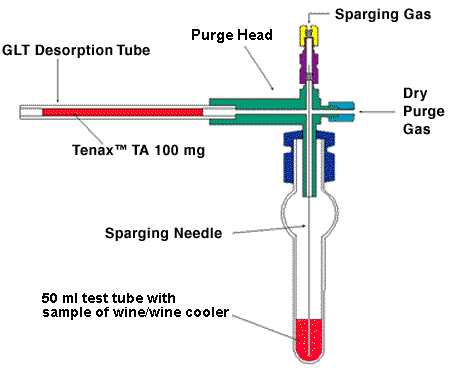
Figure 1 - Purge & Trap System
The desorption tubes with sample and internal standard were then attached to the Short Path Thermal Desorption System and a syringe needle attached. The desorption tube was injected into the GC injection port and thermally desorbed in the GC injection port at desorption block temperatures of 150 degrees C for 10 minutes at a purge flow of 50 ml/min, and a GC injection split ratio of 50:1.
RESULTS AND DISCUSSION
Flavor compounds were identified in each of the two wines examined such as: ethyl acetate, ethyl butyrate, ethyl caproate and ethyl caprylate. Additional compounds which were found in the red and burgundy wines included the alcohols isobutyl and isoamyl (impure), as well as isoamyl alcohol acetate (Figures 2 - 5). Isopropyl butyrate and 3-methyl ethyl butyrate were also detected in the burgundy wine (Figure 4). There did not appear to be any significant changes in these compounds after 6 months (Table I); however, acetal was detected in both of the wines after 6 months (Figures. 3 & 5). This may be due to an acid catalysis reaction which occurred during the 6 month period after the wines were opened. This was supported by a lower pH found in the wines which were previously opened. The aromatic compound toluene was also detected in the red wine after 6 months (Figure 3). The presence of this compound may be the result of the manufacturing process or occur naturally from essential essences.
Table I. - Relative Amounts of Volatile Organics In Wine (ng/µl)
Red Red Burgandy Burgandy Grape Dandelion
New 6 months New 6 months 30 years 2 years
-------- -------- -------- -------- -------- ---------
Ethyl Acetate 578 656 551 600 3178 1287
Isobutyl Alcohol 36 42 78 62 89 61
Acetal - 11 - 20 - -
3-Methyl Butanal - - - - 40 -
Ethyl Proprionaaate - - - - 10 -
1,1-Diethoxy-Ethane - - - - 138 22
Isoamyl Alcohol 746 737 1281 1108 413 470
Toluene - 54 - - - -
Isopropyl Propionate - - 26 40 55 78
Ethyl Butyrate 20 29 12 11 27 -
Isopropyl Butyrate - - 10 10 9 -
3-Methyl Ethyl Butyrate - - 10 13 21 8
Isoamyl Alcohol Acetate 65 55 70 80 30 16
Ethyl Caproate 213 213 83 98 53 -
Limonene - - - 11 - -
Butyl Carbitol 32 - - - - -
Ethyl Caprylate 582 751 263 304 112 20
Ethyl Pelargonate 47 - - - - -
Ethyl Caprate - - - - - 73
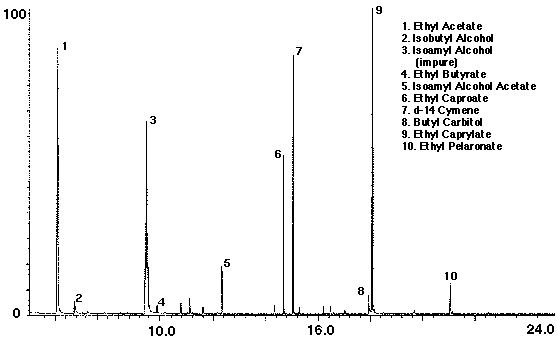
Figure 2 - Red Wine (New), 2.5ml in 25 ml H2O Collected For 10 min At 15 ml/min With 15 ml/min Dry Purge and Thermally Desorbed At 150 Degrees C For 10 min
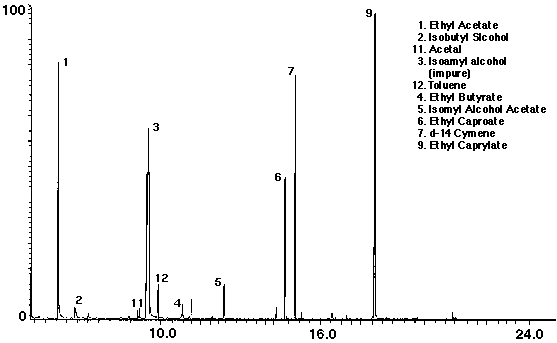
Figure 3 - Red Wine (6 mos. old), 2.5ml In 25 ml H2O Collected For 10 min At 15 ml/min With 15 ml/min Dry Purge and Thermally Desorbed At 150 Degrees C For 10 min
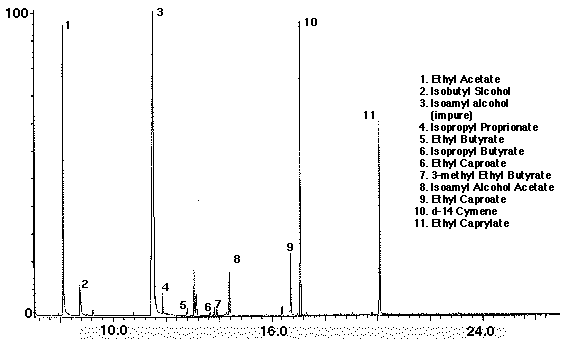
Figure 4 - Burgundy Wine (new), 2.5ml in 25 ml H2O Collected For 10 min At 15 ml/min With 15 ml/min Dry Purge and Thermally Desorbed At 150 Degrees C For 10 min
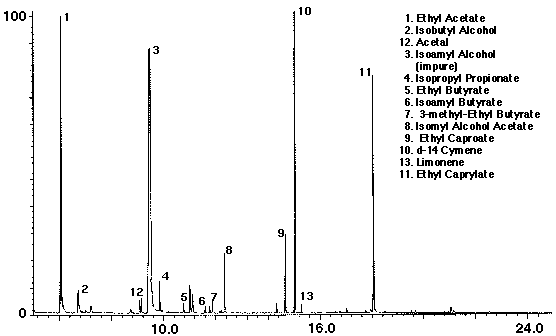
Figure 5 - Burgundy Wine (6 mons. old), 2.5ml in 25 ml H2O Collected For 10 min At 15 ml/min With 15 ml/min Dry Purge and Thermally Desorbed At 150 Degrees C For 10 min
Alcohol containing wine coolers were found to contain many common compounds such as the flavors: ethyl acetate, ethyl butyrate, 3-methyl ethyl butyrate, ethyl caproate and several monoterpenes with limonene as the most common (Figures 6 - 13). The alcohols isobutyl and isoamyl (impure) were also present in each of the flavored wine coolers (Figures 6 - 13). Additional compounds which were identified included aldehyde and alcohol derivatives. Relative amounts of these volatile organics are found in Table II. After 1 month, flavor concentrations generally decreased in each of the wine coolers with the exception of the lime-flavored wine cooler (Table II). These reductions are probably due to volatilization of the flavor compounds over the 1 month period after the wine coolers were opened.
Table II. - - Relative Amounts of Volatile Organics In the Wine Cooler (ng/µl)
Cooler Strawberry Lime Berry
New 1 mo. New 1 mo. New 1 mo. New 1 mo.
----- ------ ------ ------ ------ ------- ------ ------
Ethyl Acetate 1308 1000 2728 1200 78 117 116 86
Isobytyl Alcohol 119 50 136 144 23 41 83 83
Ethyl Propionate 10 - - 16 - - - -
Isoamyl Alcohol 542 290 520 528 257 302 375 443
Toluene - - - - 10 161 - 216
Isopropyl Propionate 56 47 40 47 - - - -
2-Methyl-methyl butyrate - - - - - - 2576 1232
Ethyl Butyrate 30 23 1576 1568 293 47 245 144
Isopropyl Butyrate - - 880 856 120 48 394 159
3-Methyl-ethyl butyrate 29 23 664 752 33 15 247 101
Myrcene - 13 - - - - - -
Benzaldehyde - - - - - - 49 80
Ethyl Caproate 27 20 512 552 261 45 123 58
Hexyl Acetate 18 14 - - 96 - - -
Cymeme 122 140 - - 28 - - -
2-ethyl-1-hexanol - - - - - 14 - -
Limonene 530 660 - - 45 - - -
Benzyl Alcohol - - - 22 - - - -
1,8-Cineole - - - - 20 22 - -
3-methyl-n-butyl-n-butyrate - - - - - - 247 92
Propyl Acetate - - 77 68 - - - -
Terpinene 189 215 - - 13 - - -
Terpinolene 31 35 - - - - - -
Linalool - - - - - - - 17
Nonanal 54 45 - - - - - -
Ethyl Benzoate - - - - 17 134 - 25
Butyl Carbitol 162 48 - - - - - -
methyl-benzyl alcohol - - - - - - 30 43
Ethyl Caprylate - - - - - 242 - -
Ethyl Pelargonate - - - - - - 56 -
Decanal 24 21 - - - - - -
1-Terpineol 27 - - - - - - -
Ionone - - - - - - - 27
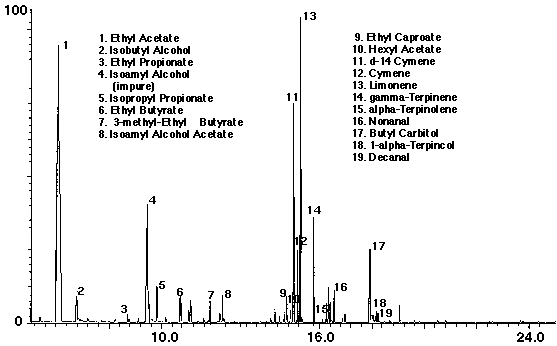
Figure 6 - Wine Cooler (new), 25 ml Collected For 10 min At 15 ml/min With 15 ml/min Dry Purge and Thermally Desorbed At 150 Degrees C For 10 min
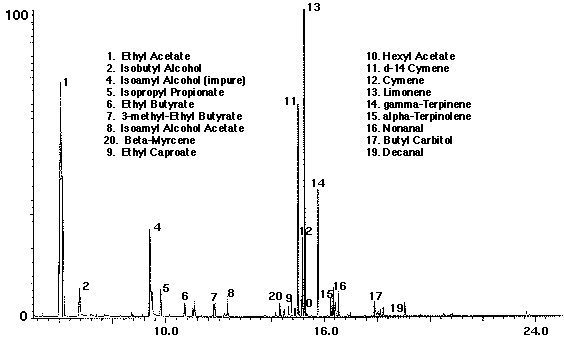
Figure 7 - Wine Cooler (1 mon. old), 25 ml Collected For 10 min At 15 ml/min With 15 ml/min Dry Purge and Thermally Desorbed At 150 Degrees C For 10 min
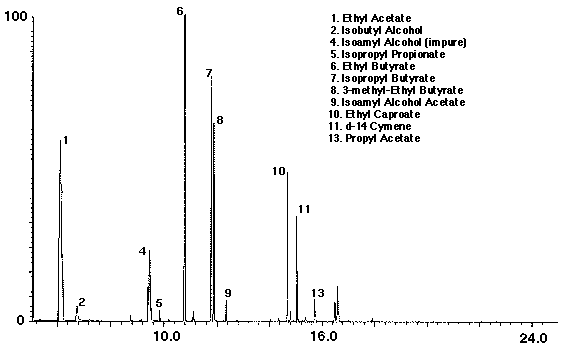
Figure 8 - Strawberry Wine Cooler (New), 25 ml Collected For 10 min At 15 ml/min With 15 ml/min Dry Purge and Thermally Desorbed At 150 Degrees C For 10 min
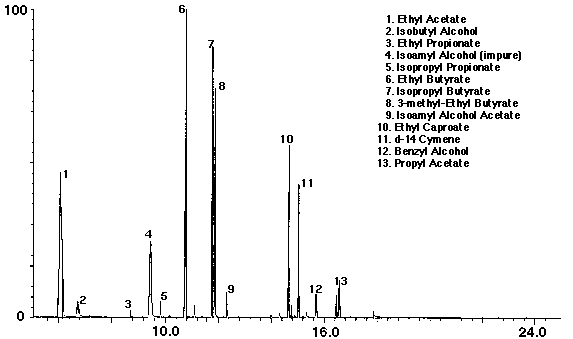
Figure 9 - Strawberry Wine Cooler (1 mon. old), 25 ml Collected For 10 min At 15 ml/min With 15 ml/min Dry Purge and Thermally Desorbed At 150 Degrees C For 10 min
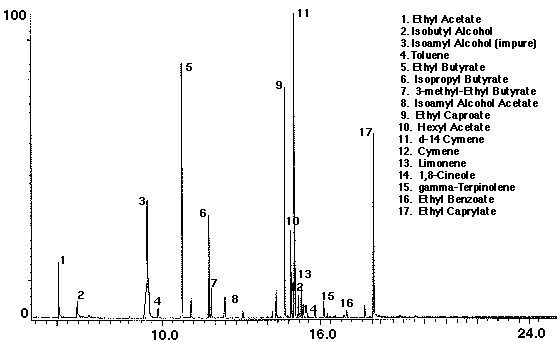
Figure 10 - Lime Wine Cooler (New), 25 ml Collected For 10 min At 15 ml/min With 15 ml/min Dry Purge and Thermally Desorbed At 150 Degrees C For 10 min
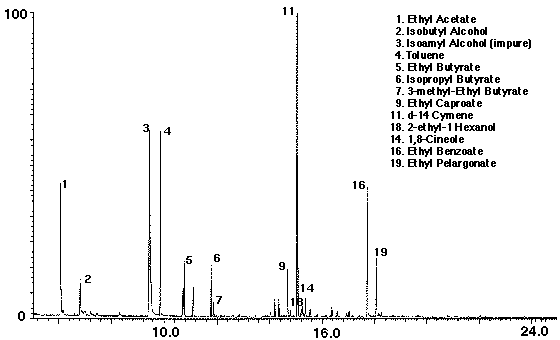
Figure 11 - Lime Wine Cooler (1 mon. old), 25 ml Collected For 10 min At 15 ml/min With 15 ml/min Dry Purge and Thermally Desorbed At 150 Degrees C For 10 min
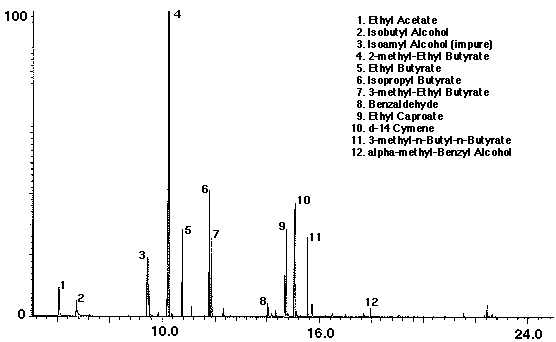
Figure 12 - Berry Wine Cooler (New), 25 ml Collected For 10 min at 15 ml/min With 15 ml/min Dry Purge and Thermally Desorbed At 150 Degrees C For 10 min
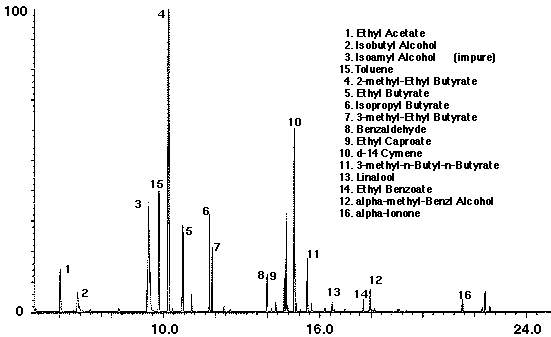
Figure 13 - Berry Wine Cooler (1 mon. old), 25 ml Collected For 10 min At 15 ml/min With 15 ml/min Dry Purge and Thermally Desorbed At 150 Degrees C For 10 min
The homemade wines contain many of the same flavors and alcohol compounds which were detected in the commercial wines (Figures 14 & 15). Both the 30-year-old grape wine and the 2-year-old dandelion wine exhibited a much higher concentration of ethyl acetate than the commercial wines, while isoamyl alcohol concentrations of the homemade wines were much lower than the commercial wines (Table I). An additional compound which was not present in the commercial wines, but detected in the homemade wines, was the natural product 1,1-diethoxy-Ethane (ethylene glycol diethyl ether), which contributes to the sweet taste of the wine.
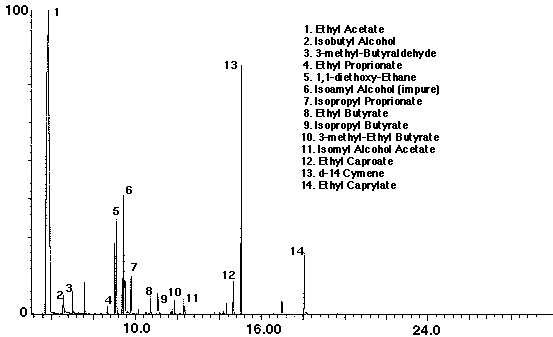
Figure 14 - 30-Year-Old Grape Wine, 2.5 ml. in 25ml H2O Collected For 10 min At 15 ml/min With 15 ml/min Dry Purge and Thermally Desorbed At 150 Degrees C For 10 min
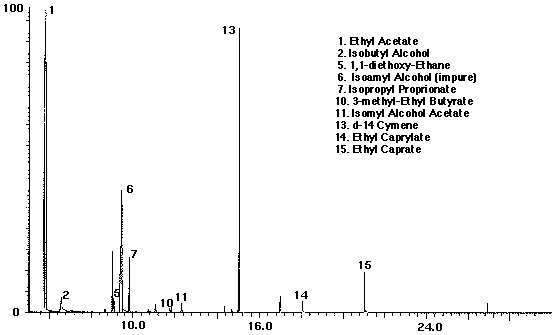
Figure 15 - 2-Year-Old Dandelion Wine, 2.5 ml. in 25ml H2O Collected For 10 min At 15 ml/min With 15 ml/min Dry Purge and Thermally Desorbed At 150 Degrees C For 10 min
CONCLUSION
Results indicate that acetal formation resulting from a lower pH over time may play a role in off-odor and unusual taste development in wine, although there appears to be very little, if any, volatilization occurring in the wines over the 6 month period. However, decreased flavor concentrations due to volatilization of the compounds in wine coolers appear to influence off-odor/off-taste development over time. In addition, oxidative reactions may occur which result in the degradation of terpenoid compounds and in the formation of by-products, as acetic acid and substituted alcohols. These may affect off-odor/off-taste development. High concentrations of the flavor ethyl acetate, as well as the presence of the natural product ethylene glycol diethyl ether in the homemade and older wines, possibly indicate a richer wine than the commercial wines analyzed. These richer and fuller wines may be due either to the aging of the wine or to the individual's recipe. The Short Path Thermal Desorption System used in conjunction with the Liquid Purge System permits the identification and quantification of trace levels of volatile organics in wines/wine coolers. This technique has also been applied to other applications such as: quantification of benzene and toluene in food products (3), and flavors and fragrances in food products (4&5), commercial products (6) and plant material (7).
REFERENCES
Hartman, T.G., Karmas, K., Chen, J., Shevade, A., Deagro, M., and H. Hwang. 1992. Determination of
Vanillin, Other Phenolic Compounds, and Flavors in Vanilla Beans. ACS Symposium Series 506. Phenolic
Compounds in Food and Their Effects on Health I. Chi-Tang Ho, Chang Y. Lee, and Mon-Tuan Huang,
Editors. pp.60-76.
Manura, J.J. 1993. Quantitation of BHT in Food and Food Packaging by Short Path Thermal Desorption.
LCGC Vol. 11 (2): 140-146.
Manura, J.J., S.V. Overton, C.W. Baker and J.N. Manos. 1990. Short Path Thermal Desorption- Design and
Theory. The Mass Spec Source Vol. XIII (4): 22-28.
Manura, J.J. and T.G. Hartman. 1992. Applications of a Short Path Thermal Desorption GC Accessory.
American Laboratory. May: 46-52.
Methodologies for the Quantification of Purge and Trap Thermal Desorption and Direct Thermal Desorption
Analyses. S.I.S. Application Note No. 9, September 1991.
Patt, J.M., Hartman, T.G., Creekmore, R.W., Elliott, J.J., Schal, C., Lech, J., and R.T. Rosen. 1992. The
Floral Odour of Peltandra Virginica contains Novel Trimethyl-2,5-Dioxabicyclo [3.2.1.] Nonanes.
Phytochemistry. Vol. 31 (2): 487-491.
Quantification of Naphthalene in a Contaminated Pharmaceutical Product by Short Path Thermal Desorption.
S.I.S. Application Note No. 10, May 1992.

